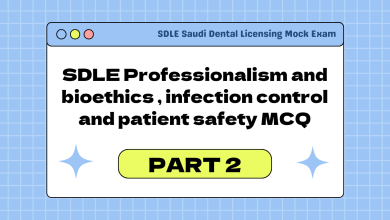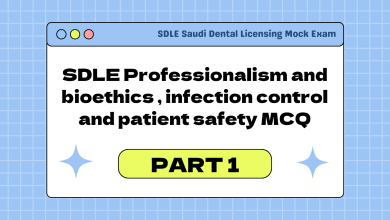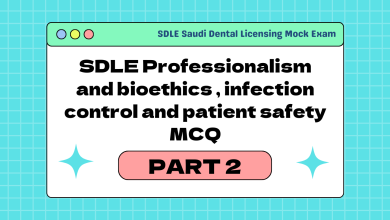Professionalism and bioethics , infection control and patient safety SDLE MCQ | Part 1

The Ultimate Guide to Conquering the SDLE: Your Strategic Blueprint for Success
Preparing for the SDLE exam is a significant milestone in every aspiring dentist’s career. It’s more than just a test of memorized facts; it’s a comprehensive assessment of your clinical judgment and deep understanding of various dental specialties. Many candidates feel overwhelmed by the vast amount of information, unsure of where to start or how to focus their efforts efficiently.
This in-depth guide is designed to be your roadmap. We will walk you through proven, strategic steps to build a robust study plan, choose the right topics, and approach the exam with the confidence needed to excel.
Part 1: The Art of Smart Topic Selection
One of the most common pitfalls in exam preparation is trying to learn everything at once. A strategic approach to selecting your study topics is not just helpful—it’s crucial for efficient and effective learning.
Why is Topic Selection a Game-Changer?
Your study time is your most valuable resource. Without a clear plan, you can easily spend hours on low-yield information while neglecting the foundational concepts that form the core of the exam. Intelligent topic selection ensures that every hour you invest brings you a higher return in knowledge and exam readiness.
Your Step-by-Step Strategy to Begin:
-
Start with Diagnosis in Every Major Subject.
Before diving deep into complex procedures, ground yourself in the diagnosis for each core specialty: Restorative (Resto), Endodontics (Endo), Prosthodontics (Pros), and Periodontics (Perio). This approach is powerful because it builds critical connections between the subjects. Since most exam questions are clinically-based, understanding how to diagnose a problem is the first and most essential step toward finding the correct solution. You’ll start to see the “big picture” of patient care. -
Identify and Master the Foundational Topics.
Every specialty has a set of fundamental principles that appear again and again. Your initial goal is not to become an expert in every rare condition, but to achieve complete mastery over these core topics. Think of it as building a strong skeleton; once that is in place, you can easily attach more detailed knowledge.
Part 2: Your Detailed Study Blueprint: What to Focus On
The SDLE exam is designed to test your basic knowledge, which means it consistently draws from a predictable set of high-yield topics within each specialty.
A Deep Dive into Key Specialties:
1. Restorative Dentistry
-
Diagnosis: The ICDAS System (International Caries Detection and Assessment System) is paramount. You must know it inside and out.
-
Classifications: Be thoroughly familiar with cavity classifications (Black’s, etc.).
-
Amalgam: Understand its phases, types of failures, and preparation design principles.
-
Partial Coverage: Differentiate clearly between inlays and onlays, including their indications and preparations.
Understanding ICDAS: A Practical Guide
ICDAS provides a standardized method for assessing caries. Here is a clear breakdown:
| Code | Description |
|---|---|
| 0 | Sound tooth surface |
| 1 | First visual change in enamel (seen only after drying) |
| 2 | Distinct visual change in enamel |
| 3 | Localized enamel breakdown without visible dentin |
| 4 | Underlying dark shadow from dentin |
| 5 | Distinct cavity with visible dentin |
| 6 | Extensive distinct cavity with visible dentin |
2. Endodontics
-
Diagnosis: Master pulp testing, percussion, palpation, and radiographic interpretation.
-
Materials: Know the composition, pH, and side effects of key materials like irrigants and sealers.
-
Surgical Procedures: Understand the indications and steps for an apicectomy.
-
Regeneration: Be clear on the indications and materials used in regenerative endodontics.
-
Files: This is a favorite area for examiners. Learn the colors, cross-sections, and specific properties of different file systems, especially hand files like K-files and H-files.
-
Rotary Systems: Understand the basic principles and safety protocols.
3. Periodontics
-
Diagnosis: Be fluent in both the old and new (2017) classification systems for periodontal diseases.
-
Probes: Know the different types of probes and their specific markings.
-
Periodontal Diseases: Understand the etiology and characteristics of gingivitis and various forms of periodontitis.
-
Instruments: Identify and know the uses of scalers, Gracey curettes, and water irrigation systems.
-
Maintenance: Understand the protocols for supportive periodontal care and re-evaluation.
Part 3: Mastering the Question Bank: A Strategic Tool, Not a Crutch
Many candidates use question banks, but few use them optimally. The key is to approach them after you have built a strong foundational knowledge.
How to Truly Leverage Old Questions to Your Advantage:
-
Look for Recurring Patterns. As you go through question sets, you will start to notice that certain topics are tested repeatedly. These are your high-yield areas. Keep a log of these topics and ensure you know them cold.
-
Study the Topic, Not Just the Question. Don’t just memorize the answer to a specific question. When you encounter a question about, for example, “Wharton’s tumor,” don’t just note that the answer is the submandibular gland. Instead, open your textbook and read the entire section on salivary gland tumors. This transforms a single question into a comprehensive learning session.
-
Always Cross-Reference with Reliable Sources. Your primary sources of information should be standard textbooks and current scientific literature. Use the question bank to identify gaps in your knowledge, and then fill those gaps with authoritative material.
-
Take Notes on Every Answer Choice. When reviewing a question, don’t just look at the correct answer. For every incorrect option, write down a brief note explaining why it is wrong. This active learning technique forces you to cover a much broader scope of information and deepens your understanding significantly.
-
Learn from Colleagues. Connect with peers who have recently taken the exam. They can provide valuable insights into the exam’s focus and atmosphere. However, filter this advice—everyone’s experience is subjective.
-
Answer Questions on Your Own First. Resist the temptation to immediately look at the answers. Challenge yourself to reason through the question independently. This builds critical thinking and problem-solving skills that are essential for the exam.
Part 4: Demystifying Exam Difficulty and Building Confidence
It’s natural to feel anxious, especially when you hear stories about “impossible” questions. Let’s reframe that thinking.
Are All the Questions Difficult? Absolutely Not.
Any well-constructed exam has a mix of easy, moderate, and difficult questions. The difficult ones are typically a small percentage, while the bulk of the exam consists of questions of easy to moderate difficulty. The psychological trap is that our brains tend to remember and talk about the challenging questions we faced. This creates a false impression that the entire exam was overwhelmingly hard.
The Takeaway: Don’t let post-exam stories from colleagues panic you. If you find a subject challenging, go back and solidify your basic understanding in that area. A strong foundation will allow you to confidently answer the majority of the questions.
Part 5: Essential Mindset and Final Takeaways for Success
Your preparation isn’t just about intellectual knowledge; it’s also about the right mindset and habits.
Your Success Mantra:
-
Invest Your Time Wisely. The exam is challenging but passable for those who are well-prepared. Consistent, focused study is an investment that will pay off immensely, not just for the exam but for your clinical career.
-
Rethink Study Groups. Avoid using study groups for initial learning. They often become inefficient social sessions. However, they can be excellent for final revision, quizzing each other, and discussing complex topics after you have done your individual studying.
-
Build an Unshakeable Foundation. Prioritize depth over breadth in your core subjects. A deep understanding of fundamental principles will allow you to deduce answers to questions you may not have directly studied.
-
Aim for Mastery, Not Just Passing. Go into the exam with the goal of truly understanding the material. This mindset shift reduces anxiety and fosters a more profound, long-lasting knowledge that will serve you far beyond the exam hall.
Examples of Professionalism and bioethics, infection control and patient safety SDLE MCQ
1. Question: What is the correct sequence for removing Personal Protective Equipment (PPE) to minimize contamination?
A. Mask → Gown → Gloves → Goggles
B. Gloves → Gown → Goggles → Mask
C. Gown → Gloves → Goggles → Mask
D. Goggles → Gloves → Gown → Mask
Correct Answer: 2 (B)
Explanation: Gloves are considered the most contaminated and are removed first, followed by the gown, then goggles, and finally the mask, which is the least contaminated.
2. Question: How should an alginate impression be disinfected before sending it to the dental laboratory?
A. Soak in bleach solution
B. Spray with an iodophor disinfectant
C. Rinse under tap water
D. Sterilize in an autoclave
Correct Answer: 2 (B)
Explanation: Spraying with an iodophor is effective for disinfection and does not cause significant dimensional change or distortion of the alginate material.
3. Question: A competent 25-year-old patient needs a costly crown. Her husband insists on a cheaper extraction. What is the most ethical action?
A. Follow the husband’s request to avoid conflict
B. Proceed with the extraction as it is more economical
C. Obtain informed consent directly from the patient
D. Refuse to provide any treatment
Correct Answer: 3 (C)
Explanation: The principle of autonomy requires that a competent adult patient must be the one to give informed consent for their own treatment, regardless of family opinions.
4. Question: Which of the following is the BEST method for sterilizing non-disposable dental burs?
A. Soaking in 70% isopropyl alcohol
B. Using dry heat sterilization
C. Wiping with a disinfectant wipe
D. Boiling in water
Correct Answer: 2 (B)
Explanation: Dry heat sterilization is the recommended method for sharp instruments like burs, as it effectively sterilizes without causing corrosion or blunting the cutting edges.
5. Question: A dentist posts a “before and after” treatment photo of a famous patient on a public social media account, showing the patient’s face, without obtaining permission. Which principle is primarily violated?
A. Justice
B. Veracity
C. Confidentiality
D. Non-maleficence
Correct Answer: 3 (C)
Explanation: Sharing identifiable patient information, including images, without explicit consent is a direct violation of patient confidentiality.
6. Question: What is the recommended duration for performing a routine hand wash with soap and water in a dental clinic?
A. At least 5-10 seconds
B. At least 20-30 seconds
C. At least 60 seconds
D. At least 2 minutes
Correct Answer: 3 (C)
Explanation: A hand wash duration of about 60 seconds (or 20-30 seconds of vigorous lathering) is recommended to ensure all surfaces of the hands are thoroughly cleaned.
7. Question: A new, inexperienced dentist damages a patient’s lingual nerve during a routine third molar extraction. This is most accurately described as:
A. A surgical complication
B. An unavoidable error
C. Malpractice
D. A violation of veracity
Correct Answer: 3 (C)
Explanation: When a healthcare provider’s lack of skill or failure to meet the standard of care causes patient harm, it constitutes malpractice.
8. Question: For a 17-year-old patient with a dental emergency who is unable to provide consent and has no guardian present, what is the most appropriate immediate action?
A. Wait until a parent can be contacted for consent
B. Provide only pain medication, not definitive treatment
C. Proceed with the necessary emergency treatment
D. Refer the patient to a hospital emergency room
Correct Answer: 3 (C)
Explanation: In a genuine emergency where delay would cause harm, treatment can and should be provided under the doctrine of implied consent to prevent further injury or alleviate severe pain.
9. Question: A patient vomits on the clinic floor. After removing the visible waste with absorbent paper towels, how should the soiled towels be classified?
A. General waste
B. Recyclable waste
C. Hazardous (infectious) waste
D. Chemical waste
Correct Answer: 3 (C)
Explanation: Waste contaminated with bodily fluids like vomit, which may contain pathogens, must be classified and disposed of as hazardous infectious waste.
10. Question: The ethical principle of “veracity” in dentistry primarily obligates the dentist to:
A. Be fair to all patients
B. Do good for the patient
C. Be truthful with the patient
D. Avoid causing harm to the patient
Correct Answer: 3 (C)
Explanation: Veracity is the principle of truth-telling and honesty, requiring dentists to provide patients with accurate information about their diagnosis, prognosis, and treatment options.
Conclusion: Your Journey to Success Starts Now
The path to SDLE success is a marathon, not a sprint. It requires careful planning, disciplined execution, and a positive, resilient mindset. Start by strategically selecting your topics, build your knowledge layer by layer, and use practice questions as a diagnostic tool to refine your understanding.
Remember, confidence is born from competence. Every well-understood topic, every mastered concept, and every strategically studied hour brings you closer to your goal.
You have the capability and the resources to excel. Trust your preparation, stay focused on your plan, and walk into the exam ready to demonstrate your knowledge. Good luck






